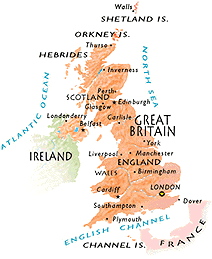
 Variety is the key to the
longstanding appeal of the United Kingdom, be it the spectacle and tradition of English
pageantry, the beauty of Scottish lochs and highlands, the conviviality of a Welsh pub, or
the castles and lakes of Northern Ireland.
Variety is the key to the
longstanding appeal of the United Kingdom, be it the spectacle and tradition of English
pageantry, the beauty of Scottish lochs and highlands, the conviviality of a Welsh pub, or
the castles and lakes of Northern Ireland.
Points of Interest
Area: 94,247 square miles (twice the size of New York State). Population:
58,610,000 (London, 7,640,000; Birmingham, 2,271,000; Manchester, 2,252,000; Glasgow,
681,000). Languages: English, Welsh and Scots Gaelic.
Highlights
London is a grand adventure for both first-time and
frequent visitors. A city tour aboard a double-decker bus provides an excellent
introduction to this ever-lively city. For another perspective, take a boat ride on the
Thames. Cruises leave from Westminster and Charing Cross piers and travel downstream to
the Tower of London and Greenwich (where the huge Millennium Dome is under construction),
or upstream to Kew Gardens and Hampton Court with its famous maze.
Independent walkers can follow the Heritage Walk through the financial district, known as the City, or the Silver Jubilee Walkway that covers dozens of major sights.
Spectacles include Changing the Guard at Buckingham Palace (every other day, daily in summertime); and the annual Opening of Parliament in November, when throngs line the route as the Queen rides from Buckingham Palace accompanied by her Household Cavalry. The palace is open to the public during August and September. Visitors can tour the Houses of Parliament and even attend certain sessions (best to apply in advance; contact the tourist office for details).
Popular day trips from London include visits to the university cities of Oxford and Cambridge, and to Windsor, site of Britain's most famous castle, recently restored and reopened.
The North Country offers marvelous landscapes and architecture. The Lake District is an 885-square-mile national park, offering changing views of mountains, lakes and valleys. The Bront‘ sisters set Wuthering Heights and Jane Eyre in the Yorkshire Dales and North York Moors. The Gothic cathedral in York and the Romanesque cathedral in Durham are among Britain's most magnificent.
Other major cities are Liverpool, birthplace of the Beatles; and Manchester, best known for its libraries and thriving arts scene. Birmingham, in the Midlands, is Britain's second-largest city and also a growing cultural center.
The West Country is also well served in literature. Chawton in Hampshire is where Jane Austen wrote Pride and Prejudice. Agatha Christie lived in South Devon and wrote two novels at the Burgh Island Hotel. Dorset became part of Thomas Hardy's fictional shire, Wessex; and Salisbury is where Anthony Trollope got the idea for his Barchester novels. Wild Dartmoor National Park is the setting for the great Sherlock Holmes story, The Hound of the Baskervilles, and the ruins of the abbey in Glastonbury reputedly hold the remains of King Arthur. The little fishing villages around Cornwall are settings for many of Daphne du Maurier's stories.
Also in the West Country are Bath, famous for its natural hot springs, Roman remains and Georgian architecture; and Plymouth, starting point for such voyagers as the Pilgrims and Sir Francis Drake.
Scotland offers highlands (Ben Nevis at 4,000 feet is the tallest point in the British Isles), lochs (including Loch Ness, of monster fame) and the romantic appeal of ancient gardens and castles. Glasgow has blossomed into a center of the arts. Edinburgh, the capital, is dominated by its castle, where Mary Queen of Scots gave birth to James VI of Scotland (England's James I). Garden enthusiasts can admire the magnificent Inverewe Garden near Gairloch.
Wales is a land where song and music are well appreciated. Attend a local choir concert or informal rehearsal, or perhaps an eisteddfod (music festival). Folk dancing, carnivals, amateur theater and opera and tasty food are other Welsh traditions. In Cardiff, the capital, is a castle that dates to Roman times. Other noteworthy castles include Caernarfon, site of the investiture of the Prince of Wales; and Powis near Welshpool. Scenic highlights include the mountains of Snowdonia in the north and coastal towns such as Swansea, home of Dylan Thomas.
Northern Ireland's attractions include the Giant's Causeway near Ballycastle - huge volcanic rock columns - and the Ulster Folk and Transport Museum. Belfast hosts Britain's second-largest arts festival in November.
